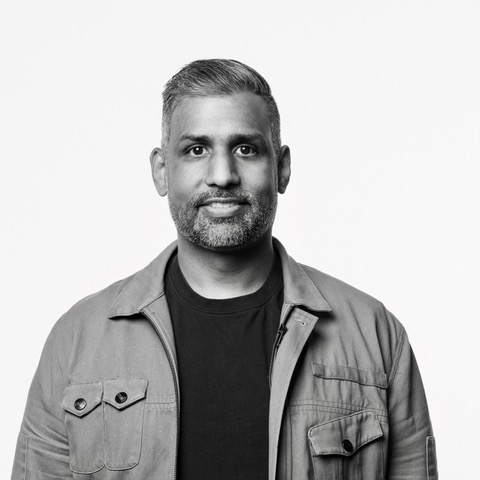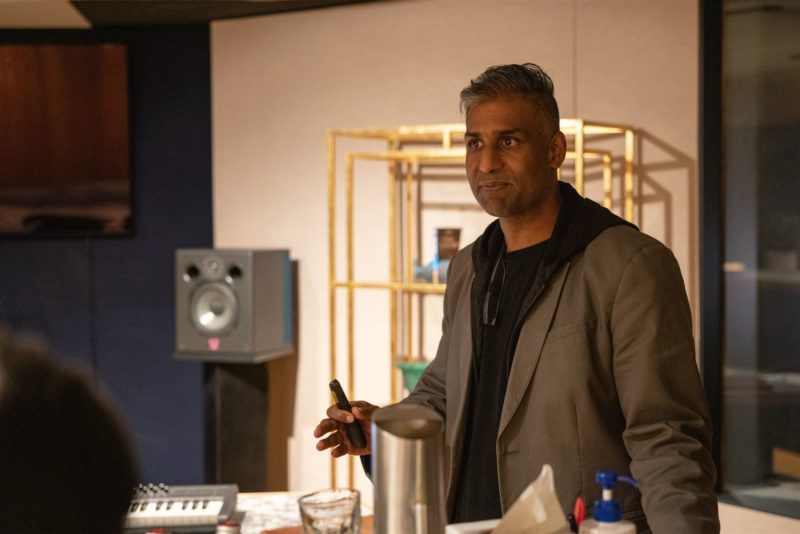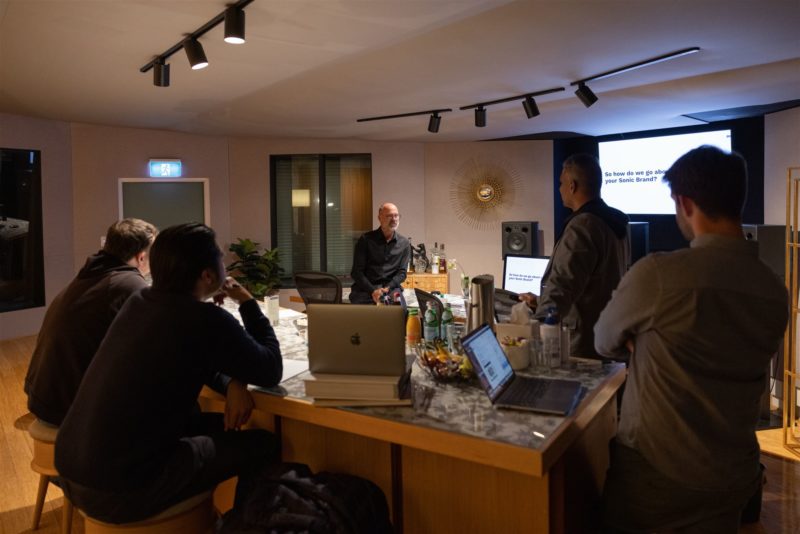
Workshopping Mumbrella’s new sonic identity
Mumbrella is finally sorting out its sonic identity in collaboration with Resonance. Was the fact it took multiple workshops down to the varied current sonic identity of the brand or something else? Mumbrella’s head of content Damian Francis spoke with Ramesh Sathiah, creative director and founder of Resonance to find out.
Damian Francis (DF): Thanks for taking the time to chat with me, Ramesh. Let’s talk about Mumbrella’s sonic identity as it stands. Mumbrella’s past use of sound was… eclectic. In approaching the challenge what were the most important items to address in your mind?
Ramesh Sathiah (RS): Mumbrella was using sound inconsistently. From the Mumbrellacast through to events, awards and content series different music was used to varying degrees of success. So creating a consistent sound was the first step. This way, audiences would always know who was talking to them.
Music plays different roles when used in different contexts. So we wanted Mumbrella’s sonic brand to be able to not only provide Mumbrella’s online content with the seal of approval, but also help Mumbrella build a relationship with its audience by conveying the reasons we trust and rely on Mumbrella for our industry news.
Once we got going, it was clear that the main creative challenge was going to be to balance the seriousness and urgency required when reporting news, with the creativity and personality of the media and marketing industry.

Ramesh Sathiah
DF: In all, there were a number of workshops that hopefully allowed Resonance to get to that stage of finding sounds that balanced seriousness and urgency. We did a couple to get a feel for what Mumbrella wanted and then a number of workshops to analyse ideas from Resonance, provide feedback and refine the results. What is the basic methodology Resonance uses to get from challenge to finished product? The team at Mumbrella has no idea what to expect, if we’re honest.
RS: We think before we play. That starts with an audit of how you and your competitors use sound currently, and what has been done in the past. In Mumbrella’s case, that meant considering content not just from the website but from award nights and highlights, live events, and of course the podcast. And comparing that to competitors in Australia and some leaders abroad. Importantly, Mumbrella features the best examples of work in media and marketing so Mumbrella’s own branding needs to keep good company.

Sathiah leading a creative workshop with Mumbrella
DF: Thank you, that final part was the right answer. Go on…
RS: We get to know each other and present our findings and strategic recommendations on how to use music or sound, identifying areas of opportunity and considering future trends and uses.
We then define your sonic essence. This is an articulation of the soul of your brand in music. We develop this by discussing your brand mission, purpose, vision, values, personality, visual and verbal identities with you to identify what best describes the brand and how you want your customers to feel. Some sonic essences are one word or phrase. Others are pictures. Whatever they are, the simpler the better.
Finally we run a sonic moodboarding exercise to narrow in on specific musical styles and genres that feel right for the brand.
Before we start composing, we compile sonic moodboards of existing music that match the sonic essence attributes, and pick out the musical elements that contribute to any positive or negative feedback. And we discuss creative ideas that can add a layer of meaning – whether it is a voice, instrument, rhythm or sound effect.
All of this information is distilled into a creative brief that is given to hand-picked composers from Resonance’s pool of specialist composers and producers.
DF: That’s interesting, because while we are involved in the multiple workshops, this is the part we, and I assumed brands you work with, don’t really see. What happens after the workshop ends…
RS: Yeah. We start with a longer piece of music, and create a 60-90 second ‘brand anthem’ from which elements and melodies will form the basis for the audio logo.
During the composition and design process, we run a series of creative presentations to shortlist preferred tracks and develop the execution of the creative idea. At first we ask clients to focus on the overall feeling of the music and its fit for the brand. As we progress, we discuss the finer details and provide examples of how the music could work with different content and in a range of contexts.
With a signed-off piece of music, we turn it into different assets such as an audio logo, brand campaign track, a podcast theme and suite of assets and short social assets.
Once all assets have been approved, and researched with consumers if required, we do a final technical test to ensure the audio is optimised for key environments and use cases and deliver files alongside a “How to Resonate” sonic guidelines document.

DF: OK, that’s all nice and neat, but brand goals for sonic identity can be particularly vague. For example, Mumbrella wanted to add trust, convey a sense of authority and sound entertaining at the same time. How do you determine what that sounds like for the brands you work with?
RS: We start by defining the sonic essence of a brand. It becomes the north star and dictates how the music should make the listener feel when interacting with the brand.
Broadly speaking, the combination of the style, genre, key, harmony, tempo and beat can help establish the right tone or mood. Other elements like melodies, motifs, sound effects and instrumentation and voices combine to add character, personality and uniqueness.
In the case of Mumbrella, we used one of the phrases used in our first workshop as their Sonic Essence: ‘Tell it like it is’.
This attitudinal phrase strikes the right balance between confidence, professionalism and challenging the status quo.
DF: Which is still pretty challenging to put into sound. When it comes to workshopping sonic ideas, a lot of the time you are dealing with clients who don’t have an audio background, like the majority of the Mumbrella editorial team. How useable is their feedback and how much of what they say they want do they really want and actually need?
RS: We don’t expect anyone to speak in musical terms or be music aficionados.
We always start with a listening exercise to get clients to open up their ears and get used to talking about music objectively and describing what they hear and how it makes them feel.
I’ll send you an example of a piece of music we use.
When discussing sonic branding, the most important thing is to be able to listen objectively and put personal preferences to one side. So by agreeing on the articulation of the sonic essence together first, we always try to frame feedback questions in the context of what is right for the brand and how it makes you feel.
Once the music has captured the right feeling, we can get a bit more technical, focusing on specific elements of the creative idea and musical execution, like instruments, voices, melodies, lyrics or sound effects. By providing options, comparisons and practical examples, we can help guide clients through the shortlisting and approval process.
DF: We went in relatively cold, knowing not much more than we had to improve what we sounded like. How should we have prepared for the experience to get the most out of it?
RS: Some of the most interesting discussions we have with clients in the initial stages are around their brand pillars. Some brands have lots of words and rules but struggle to distil them, whereas others have nothing formalised but can tell you exactly what the brand and the organisation stands for.
We were very lucky to be able to run this process with Mumbrella with a great mix of people with different perspectives on the brand, which allowed us to discuss everything from the founding principles through to the future ambition and direction of the business.
On a practical level, it is always helpful to have a think about the assets which currently best represent your brand, the places where your customers interact with you most and have a clear idea about the role you want music to play in the future. Are you trying to reinforce your current reputation or positioning? Or are you looking to change customer perceptions? Or will sonic branding help support a new or emerging product, service or channel?
DF: I alluded to it earlier but can you give me some more detail on what goes on behind the scenes between the workshops?
RS: A lot of thinking and then a lot of listening.
Before we start composing or designing, we immerse ourselves in the brand and the sector. We audit past creative content and check out what competitors and market leaders are doing locally and globally. And we consider every possible opportunity that your brand can appear sonically.
All of that thinking leads us to develop recommendations on the creative territories that we believe are authentic, distinct and ownable.
DF: And finally, how do you then refine them?

RS: Once a territory has been chosen, we do more music searching to find specific references within the chosen genre or style that fit the brief. And our creative team develop a selection of those tracks into tailored reference tracks that are used to inform the creative brief.
We use a specialist pool of composers that understand the difference between composing brand music and music for advertising. Brand music requires a simple and single-minded mission and the freedom for it to be expressed across multiple formats, lengths and contexts.
Our composers write bespoke music from scratch guided by the Sonic Essence, informed by preferred reference tracks and with a creative idea and execution in mind that imbues meaning and ultimately delivers something unique, delightful and memorable.
DF: Thanks for the time, Ramesh. We’re looking forward to dropping the final product next week.


